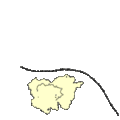Supramolecular chemistry facts for kids
Supramolecular chemistry is a special area of chemistry. It studies how individual molecules can connect and work together to create larger, more complex systems. Think of it like building with LEGOs, but on a super tiny scale!
These larger systems are held together by gentle forces called non-covalent interactions. These forces are weaker than the strong bonds that hold atoms together inside a molecule. But they are super important for many things, especially in nature. For example, they help build cell structures and even allow us to see! Scientists often get ideas for supramolecular research by looking at how living things work.
Contents
What is Supramolecular Chemistry?
Supramolecular chemistry focuses on how molecules recognize each other and then fit together. It's like a lock and key system, where one molecule (the "host") has a perfect spot for another molecule (the "guest") to fit into.
How Molecules Stick Together
Instead of strong chemical bonds, molecules in supramolecular systems use weaker attractions. These include:
- Hydrogen bonds: Like tiny magnets pulling parts of molecules together.
- Van der Waals forces: Very weak attractions that happen between all molecules.
- Electrostatic interactions: When parts of molecules with opposite electrical charges attract each other.
These gentle forces allow molecules to connect and disconnect easily. This is important because it means these systems can change and adapt, just like parts of a machine that can be put together and taken apart.
Why is Supramolecular Chemistry Important?
This field helps us understand how many things in nature work. For example:
- DNA: The two strands of DNA are held together by hydrogen bonds.
- Proteins: Proteins fold into their correct shapes using many non-covalent interactions. This shape is crucial for them to do their jobs in our bodies.
- Biological machines: Many tiny "machines" inside our cells, like ribosomes, use these weak forces to carry out important tasks.
Scientists are also using the ideas from supramolecular chemistry to build new materials and technologies.
Building Tiny Machines
One exciting part of supramolecular chemistry is creating molecular machines. These are tiny devices made of molecules that can do specific tasks, like moving or switching. Imagine a future where tiny molecular robots could deliver medicines directly to sick cells!
Scientists are also working on:
- Smart materials: Materials that can change their properties (like color or strength) when something happens, like a change in temperature.
- Drug delivery: Designing molecules that can carry medicines safely through the body and release them exactly where they are needed.
- Sensors: Creating molecules that can detect very small amounts of harmful substances.
Related Fields
Supramolecular chemistry is closely connected to other areas of science:
- Organic chemistry: This is the study of carbon-based molecules, which are the building blocks for many supramolecular systems.
- Nanotechnology: This field deals with building things on a very small scale, similar to how supramolecular chemistry works with individual molecules.
Images for kids
-
A ribosome is like a tiny biological machine that helps make proteins in cells.
See also
 In Spanish: Química supramolecular para niños
In Spanish: Química supramolecular para niños



